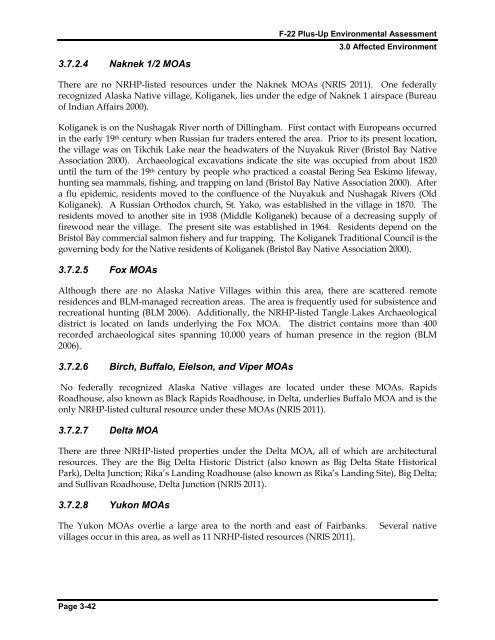F-22 Plus-Up Environmental Assessment - Joint Base Elmendorf ...
F-22 Plus-Up Environmental Assessment - Joint Base Elmendorf ...
F-22 Plus-Up Environmental Assessment - Joint Base Elmendorf ...
You also want an ePaper? Increase the reach of your titles
YUMPU automatically turns print PDFs into web optimized ePapers that Google loves.
3.7.2.4 Naknek 1/2 MOAs<br />
F-<strong>22</strong> <strong>Plus</strong>-<strong>Up</strong> <strong>Environmental</strong> <strong>Assessment</strong><br />
3.0 Affected Environment<br />
There are no NRHP-listed resources under the Naknek MOAs (NRIS 2011). One federally<br />
recognized Alaska Native village, Koliganek, lies under the edge of Naknek 1 airspace (Bureau<br />
of Indian Affairs 2000).<br />
Koliganek is on the Nushagak River north of Dillingham. First contact with Europeans occurred<br />
in the early 19 th century when Russian fur traders entered the area. Prior to its present location,<br />
the village was on Tikchik Lake near the headwaters of the Nuyakuk River (Bristol Bay Native<br />
Association 2000). Archaeological excavations indicate the site was occupied from about 1820<br />
until the turn of the 19 th century by people who practiced a coastal Bering Sea Eskimo lifeway,<br />
hunting sea mammals, fishing, and trapping on land (Bristol Bay Native Association 2000). After<br />
a flu epidemic, residents moved to the confluence of the Nuyakuk and Nushagak Rivers (Old<br />
Koliganek). A Russian Orthodox church, St. Yako, was established in the village in 1870. The<br />
residents moved to another site in 1938 (Middle Koliganek) because of a decreasing supply of<br />
firewood near the village. The present site was established in 1964. Residents depend on the<br />
Bristol Bay commercial salmon fishery and fur trapping. The Koliganek Traditional Council is the<br />
governing body for the Native residents of Koliganek (Bristol Bay Native Association 2000).<br />
3.7.2.5 Fox MOAs<br />
Although there are no Alaska Native Villages within this area, there are scattered remote<br />
residences and BLM-managed recreation areas. The area is frequently used for subsistence and<br />
recreational hunting (BLM 2006). Additionally, the NRHP-listed Tangle Lakes Archaeological<br />
district is located on lands underlying the Fox MOA. The district contains more than 400<br />
recorded archaeological sites spanning 10,000 years of human presence in the region (BLM<br />
2006).<br />
3.7.2.6 Birch, Buffalo, Eielson, and Viper MOAs<br />
No federally recognized Alaska Native villages are located under these MOAs. Rapids<br />
Roadhouse, also known as Black Rapids Roadhouse, in Delta, underlies Buffalo MOA and is the<br />
only NRHP-listed cultural resource under these MOAs (NRIS 2011).<br />
3.7.2.7 Delta MOA<br />
There are three NRHP-listed properties under the Delta MOA, all of which are architectural<br />
resources. They are the Big Delta Historic District (also known as Big Delta State Historical<br />
Park), Delta Junction; Rika’s Landing Roadhouse (also known as Rika’s Landing Site), Big Delta;<br />
and Sullivan Roadhouse, Delta Junction (NRIS 2011).<br />
3.7.2.8 Yukon MOAs<br />
The Yukon MOAs overlie a large area to the north and east of Fairbanks.<br />
villages occur in this area, as well as 11 NRHP-listed resources (NRIS 2011).<br />
Several native<br />
Page 3-42
















